Inclusive Parks across Ages: Multifunction and Urban Open Space Management for Children, Adolescents, and the Elderly
Abstract
1. Introduction
1.1. Urban Open Space Management
1.2. Developing Multifunction
2. Materials and Methods
2.1. The Selected Case
2.2. Walking Interviews
2.3. Analysis and Analytical Framework
3. Results
3.1. Children and Affordances
3.2. Children and UOS Management
3.3. Adolescents and Affordances
3.4. Adolescents and UOS Management
3.5. Elderly and Affordances
3.6. Elderly and UOS Management
3.7. Park Management
4. Discussion
4.1. Similarities and Differences between Age Groups
4.2. Developing Multifunction and Inclusiveness
4.3. Developing Socially Sustainable User Participation
4.4. Method Discussion and Future Studies
5. Conclusions
Author Contributions
Funding
Acknowledgments
Conflicts of Interest
References
- Haaland, C.; van den Bosch, C.K. Challenges and strategies for urban green-space planning in cities undergoing densification: A review. Urban For. Urban Green. 2015, 14, 760–771. [Google Scholar] [CrossRef]
- Randrup, T.; Svännel, J.; Sunding, A.; Jansson, M.; Ode Sang, Å. Urban green space management in the Nordic countries. Cities. Forthcoming.
- Dempsey, N.; Smith, H. Understanding place-keeping of open space. In Place-Keeping: Open Space Management in Practice; Dempsey, N., Smith, H., Burton, M., Eds.; Routledge: London, UK, 2014; pp. 13–29. [Google Scholar]
- Jansson, N.; Fors, H.; Sundevall, E.P.; Bengtsson, A.; Lerstrup, I.; Hurley, P.; Qviström, M.; Randrup, T.B. User-oriented urban open space governance and management. In Urban Open Space Governance and Management; Jansson, M., Randrup, T., Eds.; Routledge: London, UK, 2020; pp. 68–92. [Google Scholar]
- Fors, H.; Jansson, M.; Nielsen, A. The impact of resident participation on urban woodland quality—a case study of sletten, Denmark. Forests 2018, 9, 670. [Google Scholar] [CrossRef]
- Lindholst, A.C.; Sullivan, S.G.; van den Bosch, C.C.K.; Fors, H. The inherent politics of managing the quality of urban green spaces. Plan. Pract. Res. 2015, 30, 376–392. [Google Scholar] [CrossRef]
- Wolch, J.R.; Byrne, J.; Newell, J.P. Urban green space, public health, and environmental justice: The challenge of making cities ‘just green enough’. Landsc. Urban Plan. 2014, 125, 234–244. [Google Scholar] [CrossRef]
- Jansson, M.; Sundevall, E.; Wales, M. The role of green spaces and their management in a child-friendly urban village. Urban For. Urban Green. 2016, 18, 228–236. [Google Scholar] [CrossRef]
- Arnberger, A.; Eder, R. The influence of age on recreational trail preferences of urban green-space visitors: A discrete choice experiment with digitally calibrated images. J. Environ. Plan. Manag. 2011, 54, 891–908. [Google Scholar] [CrossRef]
- Rutt, R.L.; Gulsrud, N.M. Green justice in the city: A new agenda for urban green space research in Europe. Urban For. Urban Green. 2016, 19, 123–127. [Google Scholar] [CrossRef]
- Van Herzele, A.; Collins, K.; Tyrväinen, L. Involving people in urban forestry—A discussion of participatory practices throughout Europe. In Urban Forests and Trees; Konijnendijk, C.C., Nilsson, K., Randrup, T.B., Schipperijn, J., Eds.; Springer: Berlin, Germany, 2005; pp. 207–228. [Google Scholar]
- Molin, J.F.; Konijnendijk van den Bosch, C.C. Between Big Ideas and Daily Realities—The roles and perspectives of Danish municipal green space managers on public involvement in green space maintenance. Urban For. Urban Green. 2014, 13, 553–561. [Google Scholar] [CrossRef]
- Fors, H.; Ambrose-Oji, B.; Konijnendijk van den Bosch, C.; Mellqvist, H.; Jansson, M. Participation in urban open spcae governance and management. In Urban Open Space Governance and Management; Jansson, M., Randrup, T., Eds.; Routledge: London, UK, 2020; pp. 112–128. [Google Scholar]
- Shan, X.Z. Attitude and willingness toward participation in decision-making of urban green spaces in China. Urban For. Urban Green. 2012, 11, 211–217. [Google Scholar] [CrossRef]
- Ode Sang, Å.; Knez, I.; Gunnarsson, B.; Hedblom, M. The effects of naturalness, gender, and age on how urban green space is perceived and used. Urban For. Urban Green. 2016, 18, 268–276. [Google Scholar] [CrossRef]
- Laatikainen, T.E.; Broberg, A.; Kyttä, M. The physical environment of positive places: Exploring differences between age groups. Prev. Med. 2017, 95, 85–91. [Google Scholar] [CrossRef] [PubMed]
- Gibson, J.J. The Ecological Approach to Visual Perception; Psychology Press: New York, NY, USA, 2015. [Google Scholar]
- Veitch, J.; Salmon, J.; Deforche, B.; Ghekiere, A.; Van Cauwenberg, J.; Bangay, S.; Timperio, A. Park attributes that encourage park visitation among adolescents: A conjoint analysis. Landsc. Urban Plan. 2017, 161, 52–58. [Google Scholar] [CrossRef]
- Norðdahl, K.; Einarsdóttir, J. Children’s views and preferences regarding their outdoor environment. J. Adventure Educ. Outdoor Learn. 2015, 15, 152–167. [Google Scholar] [CrossRef]
- Laaksoharju, T.; Rappe, E. Trees as affordances for connectedness to place–a framework to facilitate children’s relationship with nature. Urban For. Urban Green. 2017, 28, 150–159. [Google Scholar] [CrossRef]
- Kemperman, A.; Timmermans, H. Green spaces in the direct living environment and social contacts of the aging population. Landsc. Urban Plan. 2014, 129, 44–54. [Google Scholar] [CrossRef]
- Wen, C.; Albert, C.; Von Haaren, C. The elderly in green spaces: Exploring requirements and preferences concerning nature-based recreation. Sustain. Cities Soc. 2018, 38, 582–593. [Google Scholar] [CrossRef]
- Yung, E.H.K.; Ho, W.K.O.; Chan, E.H.W. Elderly satisfaction with planning and design of public parks in high density old districts: An ordered logit model. Landsc. Urban Plan. 2017, 165, 39–53. [Google Scholar]
- Enssle, F.; Kabisch, N. Urban green spaces for the social interaction, health and well-being of older—An integrated view of urban ecosystem services and socio-environmental justice. Environ. Sci. Policy 2020, 109, 36–44. [Google Scholar] [CrossRef]
- Lindberg, M.; Schipperijn, J. Active use of urban park facilities—Expectations versus reality. Urban For. Urban Green. 2015, 14, 909–918. [Google Scholar] [CrossRef]
- Kaplan, R.; Kaplan, S. Adolescents and the natural environment: A time out? In Children and Nature: Psychological, Sociocultural, and Evolutionary Investigations; Kahn, P., Kellert, S., Eds.; MIT Press: Cambridge, MA, USA, 2002; pp. 227–257. [Google Scholar]
- Knöll, M.; Roe, J.J. Ten questions concerning a new adolescent health urbanism. Build. Environ. 2017, 126, 496–506. [Google Scholar] [CrossRef]
- Owens, P.E. No Teens Allowed: The exclusion of adolescents from public spaces. Landsc. J. 2002, 21, 156–163. [Google Scholar] [CrossRef]
- Clark, C.; Uzzell, D.L. The affordances of the home, neighbourhood, school and town centre for adolescents. J. Environ. Psychol. 2002, 22, 95–108. [Google Scholar] [CrossRef]
- Jansson, M.; Abdulah, M.; Eriksson, A. Secondary school students’ perspectives and use of three school grounds of varying size, content and design. Urban For. Urban Green. 2018, 30, 115–123. [Google Scholar] [CrossRef]
- Mertens, L.; Van Cauwenberg, J.; Veitch, J.; Deforche, B.; Van Dyck, D. Differences in park characteristic preferences for visitation and physical activity among adolescents: A latent class analysis. PLoS ONE 2019, 14, e0212920. [Google Scholar] [CrossRef] [PubMed]
- Jansson, M.; Vogel, N.; Fors, H.; Randrup, T.B. The governance of landscape management: New approaches to urban open space development. Landsc. Res. 2019, 44, 952–965. [Google Scholar] [CrossRef]
- Gallerani, D.G.; Besenyi, G.M.; Wilhelm Stanis, S.A.; Kaczynski, A.T. We actually care and we want to make the parks better: A qualitative study of youth experiences and perceptions after conducting park audits. Prev. Med. 2017, 95, S109–S114. [Google Scholar] [CrossRef]
- Hansen, R.; Olafsson, A.S.; van der Jagt, A.P.N.; Rall, E.; Pauleit, S. Planning multifunctional green infrastructure for compact cities: What is the state of practice? Ecol. Indic. 2017, 96, 99–110. [Google Scholar] [CrossRef]
- Shams, I.; Barker, A. Barriers and opportunities of combining social and ecological functions of urban greenspaces–Users’ and landscape professionals’ perspectives. Urban For. Urban Green. 2019, 39, 67–78. [Google Scholar] [CrossRef]
- Ahern, J. From fail-safe to safe-to-fail: Sustainability and resilience in the new urban world. Landsc. Urban Plan. 2011, 100, 341–343. [Google Scholar] [CrossRef]
- Rode, M.W. Nature conservation as part of a multifunctional use of suburban landscapes. In Urbanization and Locality; Strengthening Identity and Sustainability by Site-specific Planning and Design; Wang, F., Prominski, M., Eds.; Springer: Heidelberg, Germany, 2016; pp. 323–343. [Google Scholar]
- Yttri, D. Parken som rom for fellesskap og tilflukt i moderne byliv-et forsøk på å förstå parkers flerfunksjonelle karakter. Nord. Arkit. 2002, 1, 51–59. [Google Scholar]
- Hansen, R.; Pauleit, S. From multifunctionality to multiple ecosystem services? A conceptual framework for multifunctionality in green infrastructure planning for Urban Areas. AMBIO 2014, 43, 516–529. [Google Scholar] [CrossRef] [PubMed]
- Clark, A.; Emmel, N. Using walking interviews. Realities 2010, 13, 1–6. [Google Scholar]
- Brinkmann, S.; Kvale, S. Interviews: Learning the Craft of Qualitative Research Interviewing, 3rd ed.; Sage Publications: Los Angeles, CA, USA, 2015. [Google Scholar]
- Braun, V.; Clarke, V. Using thematic analysis in psychology. Qual. Res. Psychol. 2006, 3, 77–101. [Google Scholar] [CrossRef]
- Withagen, R.; de Poel, H.J.; Araújo, D.; Pepping, G.J. Affordances can invite behavior: Reconsidering the relationship between affordances and agency. New Ideas Psychol. 2012, 30, 250–258. [Google Scholar] [CrossRef]
- Jansson, M.; Fors, H.; Lindgren, T.; Wiström, B. Perceived safety in relation to urban woodland vegetation—A review. Urban For. Urban Green. 2013, 12, 127–133. [Google Scholar] [CrossRef]
- Nordh, H.; Alalouch, C.; Hartig, T. Assessing restorative components of small urban parks using conjoint methodology. Urban For. Urban Green. 2011, 10, 95–103. [Google Scholar] [CrossRef]
- Arnberger, A.; Allex, B.; Eder, R.; Ebenberger, M.; Wanka, A.; Kolland, F.; Wallner, P.; Hutter, H.P. Elderly resident’s uses of and preferences for urban green spaces during heat periods. Urban For. Urban Green. 2017, 21, 102–115. [Google Scholar] [CrossRef]
- Kaplan, S. The restorative benefits of nature: Toward an integrative frame-work. J. Environ. Psychol. 1995, 15, 169–183. [Google Scholar] [CrossRef]
- Schutte, A.R.; Torquati, J.C.; Beattie, H.L. Impact of urban nature on executive functioning in early and middle childhood. Environ. Behav. 2017, 49, 3–30. [Google Scholar] [CrossRef]
- Refshauge, A.D.; Stigsdotter, U.K.; Cosco, N.G. Adults’ motivation for bringing their children to park playgrounds. Urban For. Urban Green. 2012, 11, 396–405. [Google Scholar] [CrossRef]
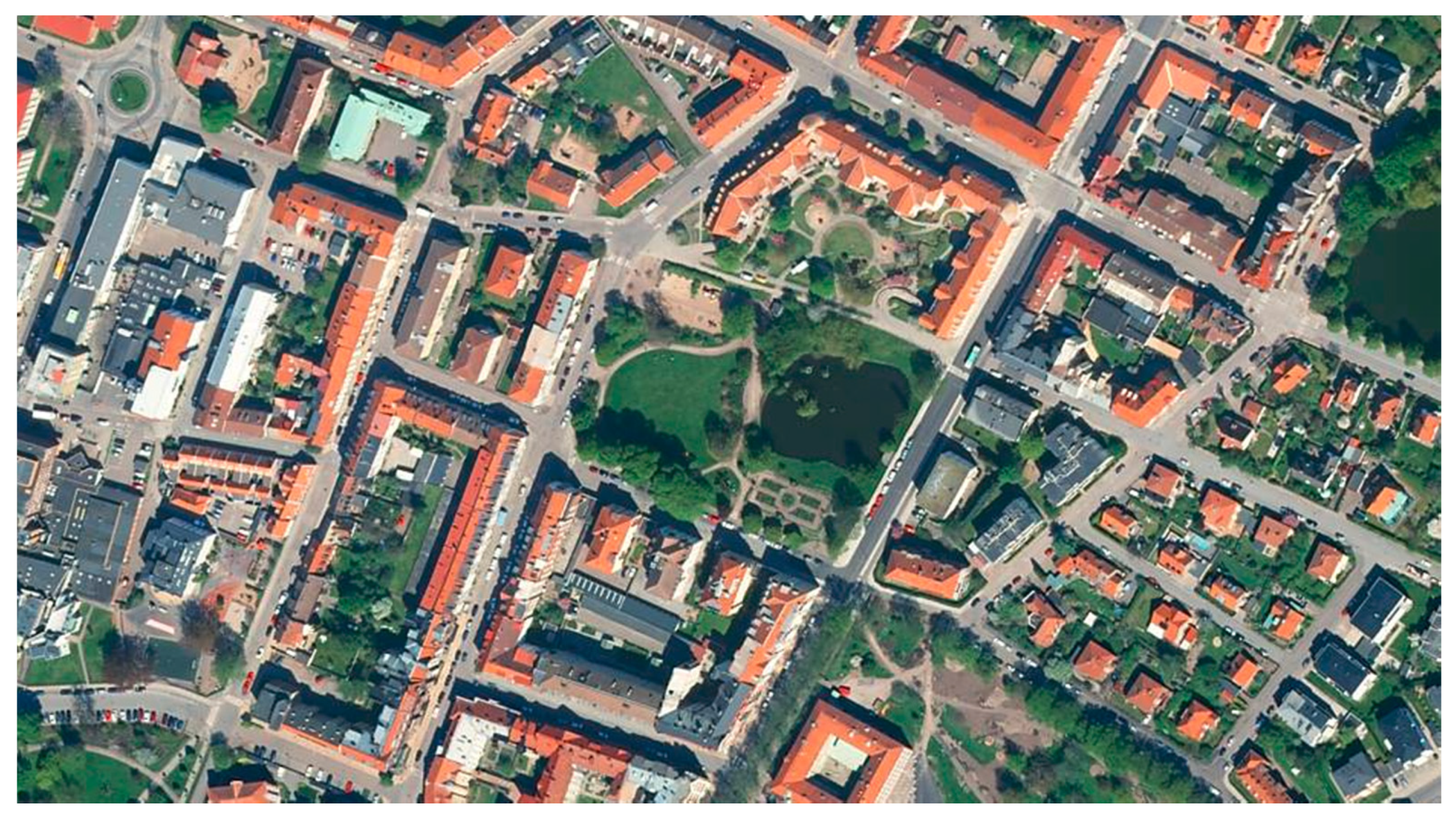
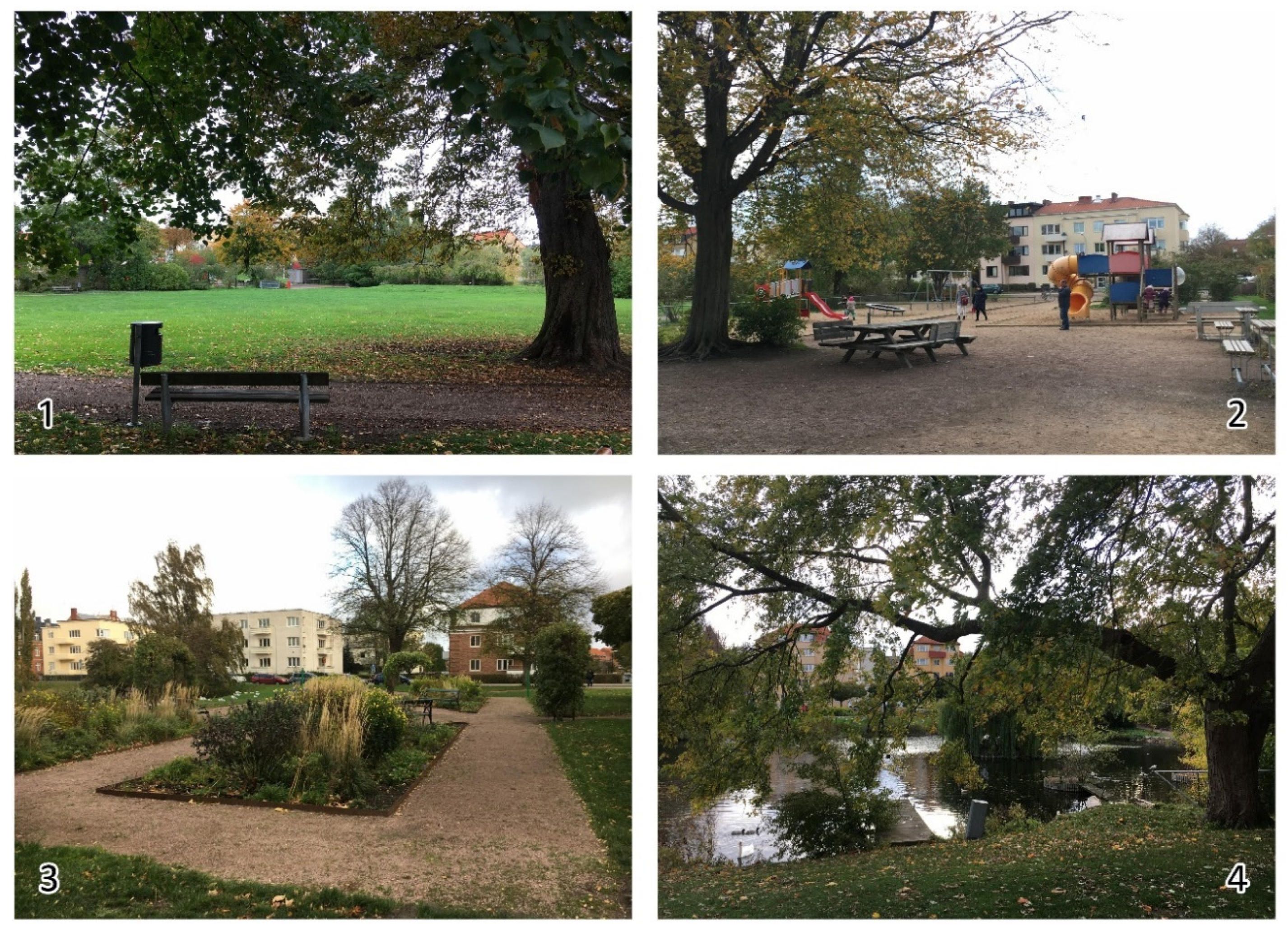

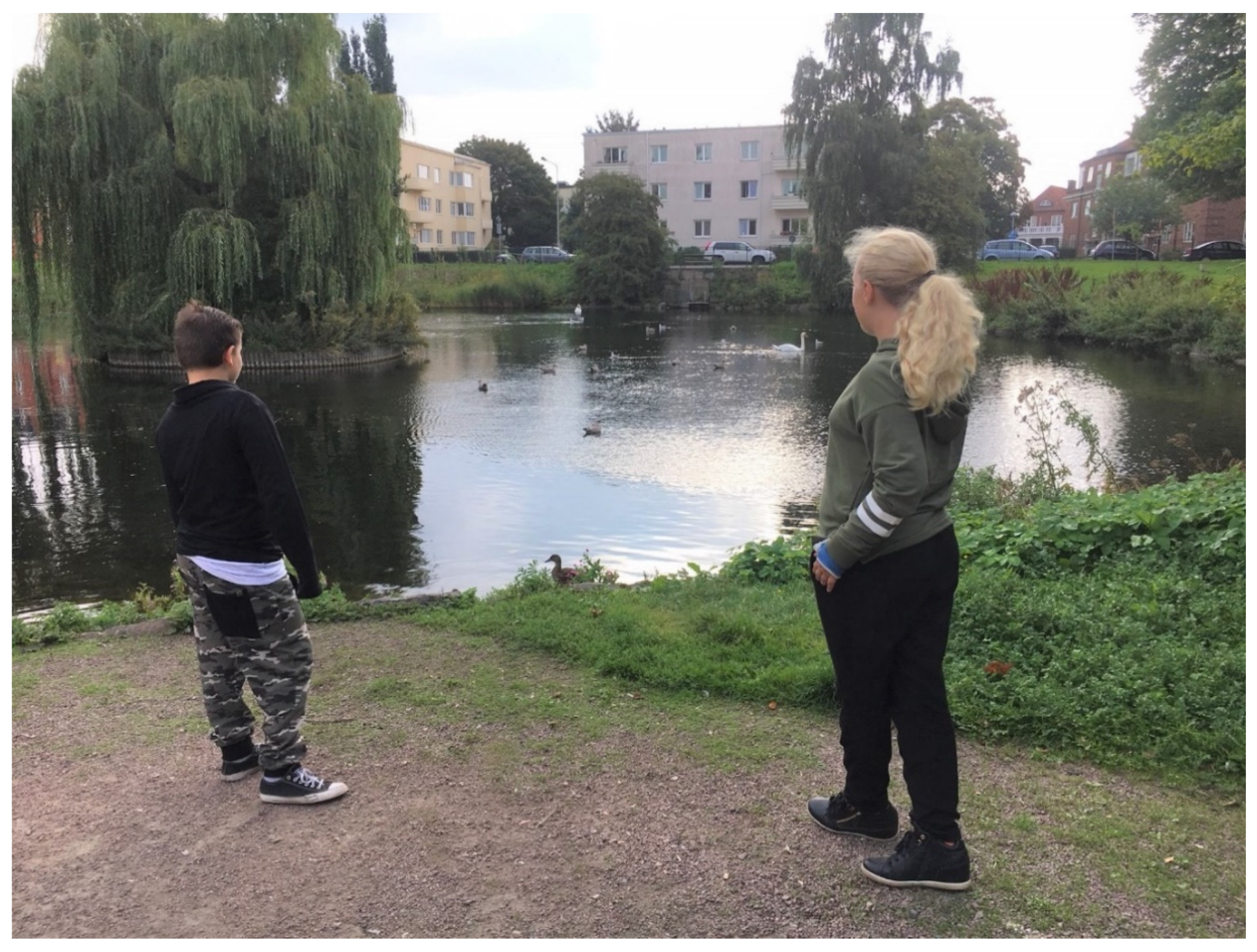
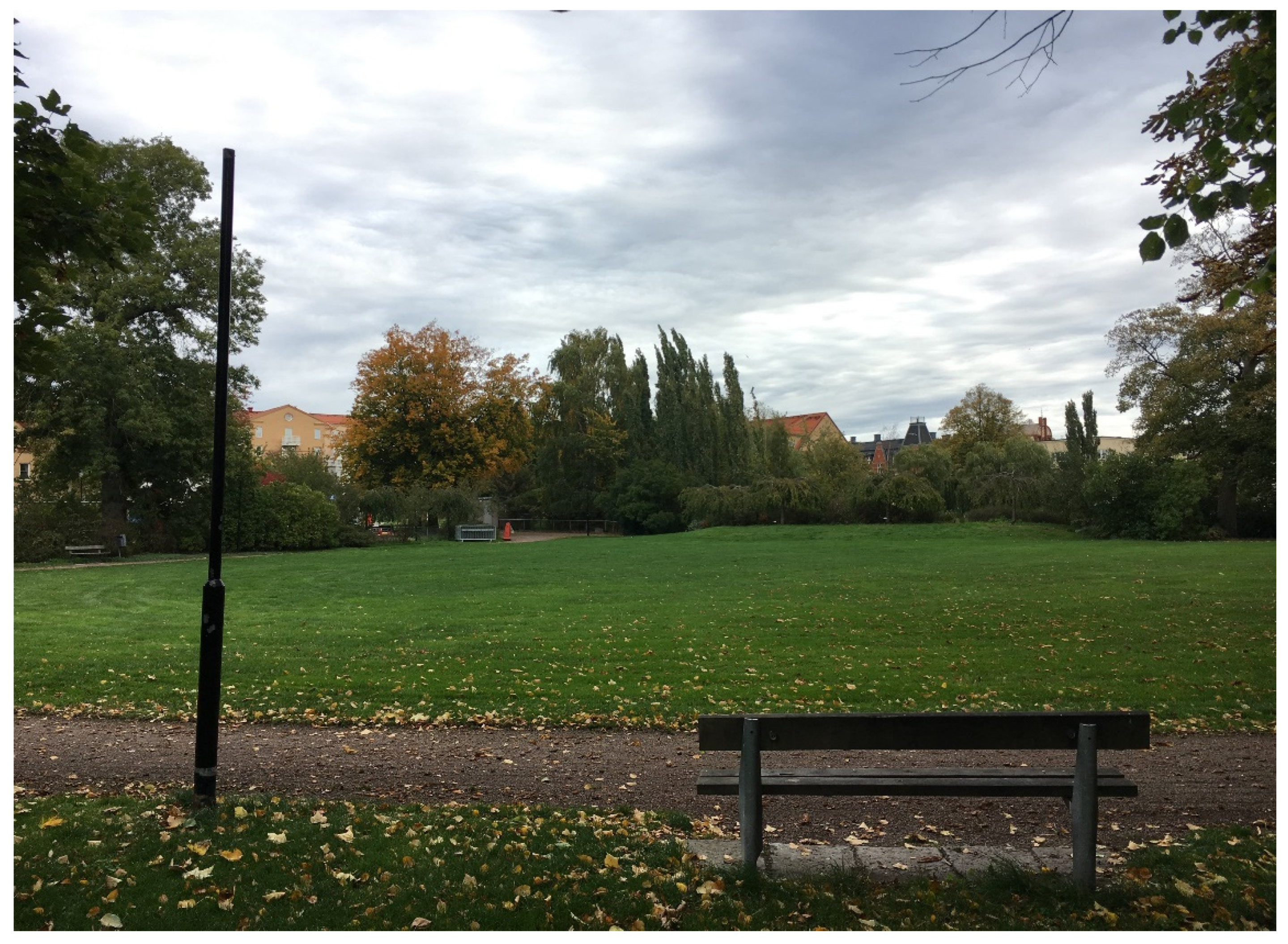
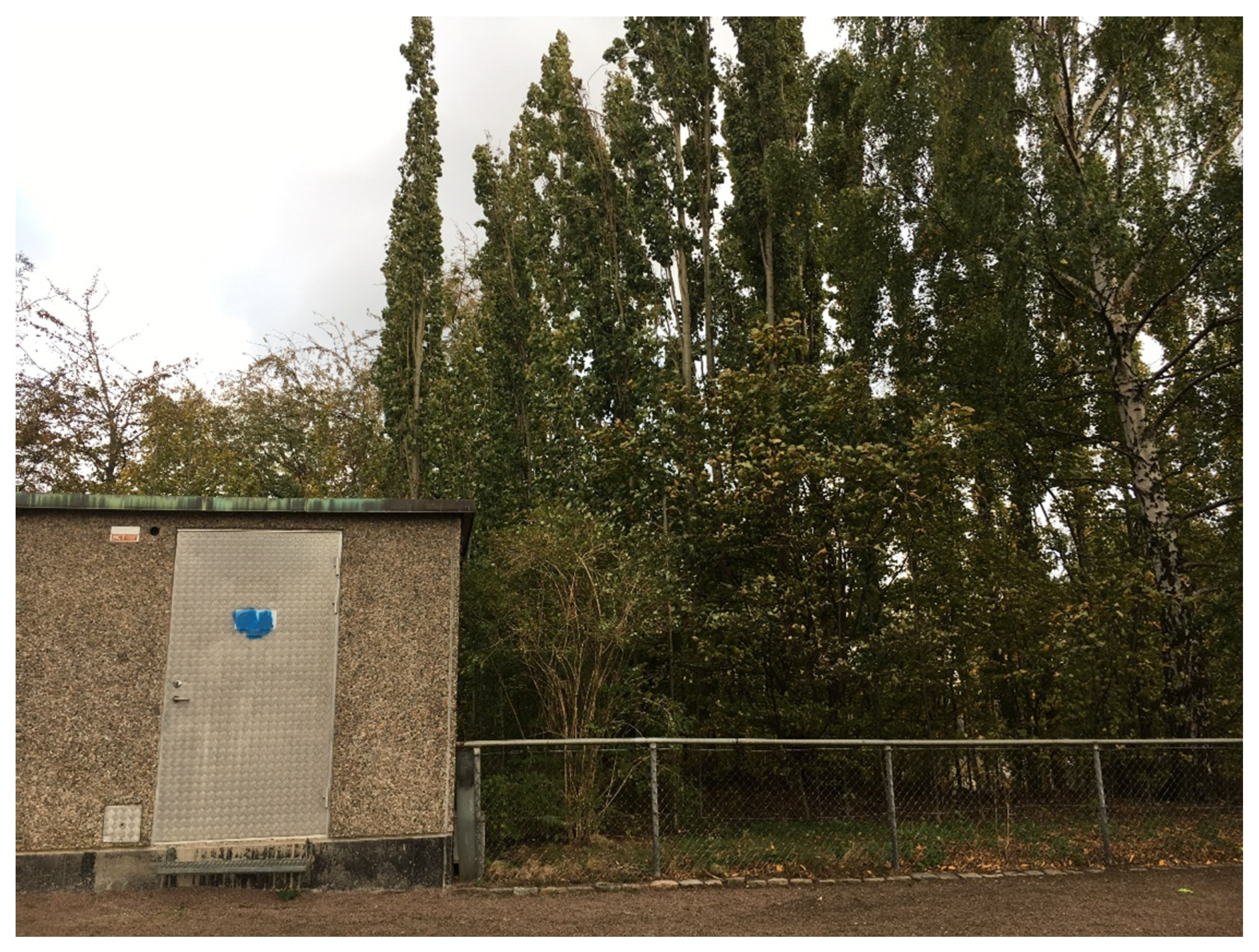
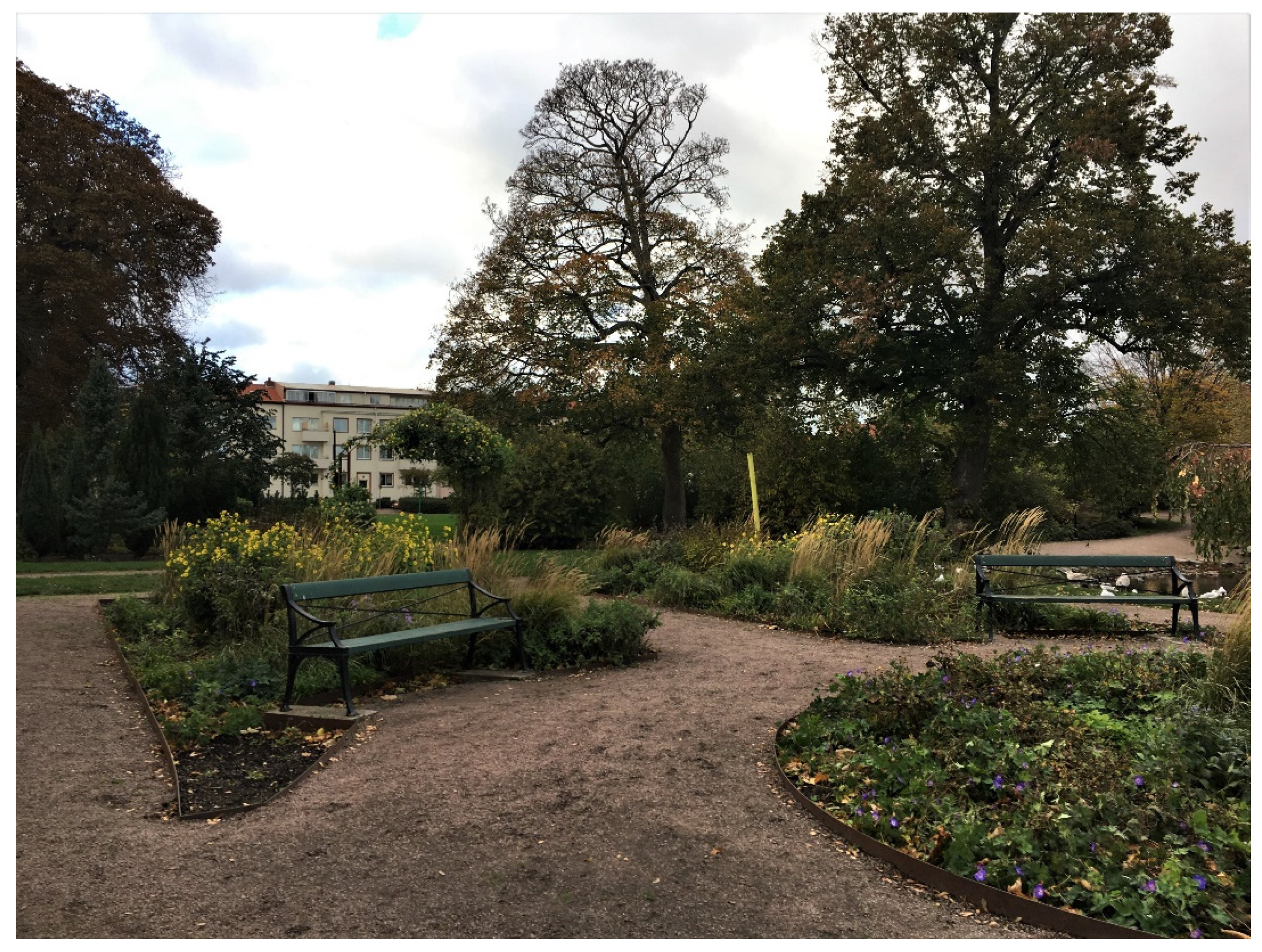
| Age Group | Interview | Gender | Age | Geographic Context |
|---|---|---|---|---|
| Children | 1 | Boy | 10 | Lived all life in Landskrona. Immigrant parents. |
| 1 | Boy | 10 | Lived all life in Landskrona. | |
| 2 | Girl | 10 | Born in the region and mainly lived in Landskrona. Immigrant parents. | |
| 2 | Girl | 9 | Lived all life in Landskrona. Immigrant parents. | |
| 3 | Boy | 10 | Lives in Landskrona since age 5. Immigrant. | |
| 3 | Girl | 10 | Lived all life in Landskrona. | |
| Adolescents | 4 | Girl | 16 | Born in Landskrona but lives in a nearby village since age 5. Immigrant parents. |
| 4 | Girl | 16 | Lived all life in Landskrona. Immigrant parents. | |
| 5 | Girl | 16 | Born in Landskrona but lives in a nearby village since age 3. Immigrant parents. | |
| 5 | Girl | 16 | Born in other part of Sweden but lives in Landskrona since age 6. Immigrant parents. | |
| 6 | Girl | 15 | Lives in Landskrona since age 5. Immigrant. | |
| 6 | Girl | 16 | Lived all life in Landskrona. Immigrant parents. | |
| Elderly | 7 | Man | 76 | Born in the region. Lives in Landskrona since 25 years. |
| 7 | Man | 69 | Lived in Landskrona all life. | |
| 8 | Woman | 75 | Born in other part of Sweden. Lives in Landskrona since several years. | |
| 8 | Woman | 66 | Born in Landskrona and has also moved back. | |
| 9 | Man | 76 | Lived in Landskrona all life. | |
| 9 | Woman | 70 | Lived in Landskrona all life. |
Publisher’s Note: MDPI stays neutral with regard to jurisdictional claims in published maps and institutional affiliations. |
© 2020 by the authors. Licensee MDPI, Basel, Switzerland. This article is an open access article distributed under the terms and conditions of the Creative Commons Attribution (CC BY) license (http://creativecommons.org/licenses/by/4.0/).
Share and Cite
Sundevall, E.P.; Jansson, M. Inclusive Parks across Ages: Multifunction and Urban Open Space Management for Children, Adolescents, and the Elderly. Int. J. Environ. Res. Public Health 2020, 17, 9357. https://doi.org/10.3390/ijerph17249357
Sundevall EP, Jansson M. Inclusive Parks across Ages: Multifunction and Urban Open Space Management for Children, Adolescents, and the Elderly. International Journal of Environmental Research and Public Health. 2020; 17(24):9357. https://doi.org/10.3390/ijerph17249357
Chicago/Turabian StyleSundevall, Elin P., and Märit Jansson. 2020. "Inclusive Parks across Ages: Multifunction and Urban Open Space Management for Children, Adolescents, and the Elderly" International Journal of Environmental Research and Public Health 17, no. 24: 9357. https://doi.org/10.3390/ijerph17249357
APA StyleSundevall, E. P., & Jansson, M. (2020). Inclusive Parks across Ages: Multifunction and Urban Open Space Management for Children, Adolescents, and the Elderly. International Journal of Environmental Research and Public Health, 17(24), 9357. https://doi.org/10.3390/ijerph17249357






